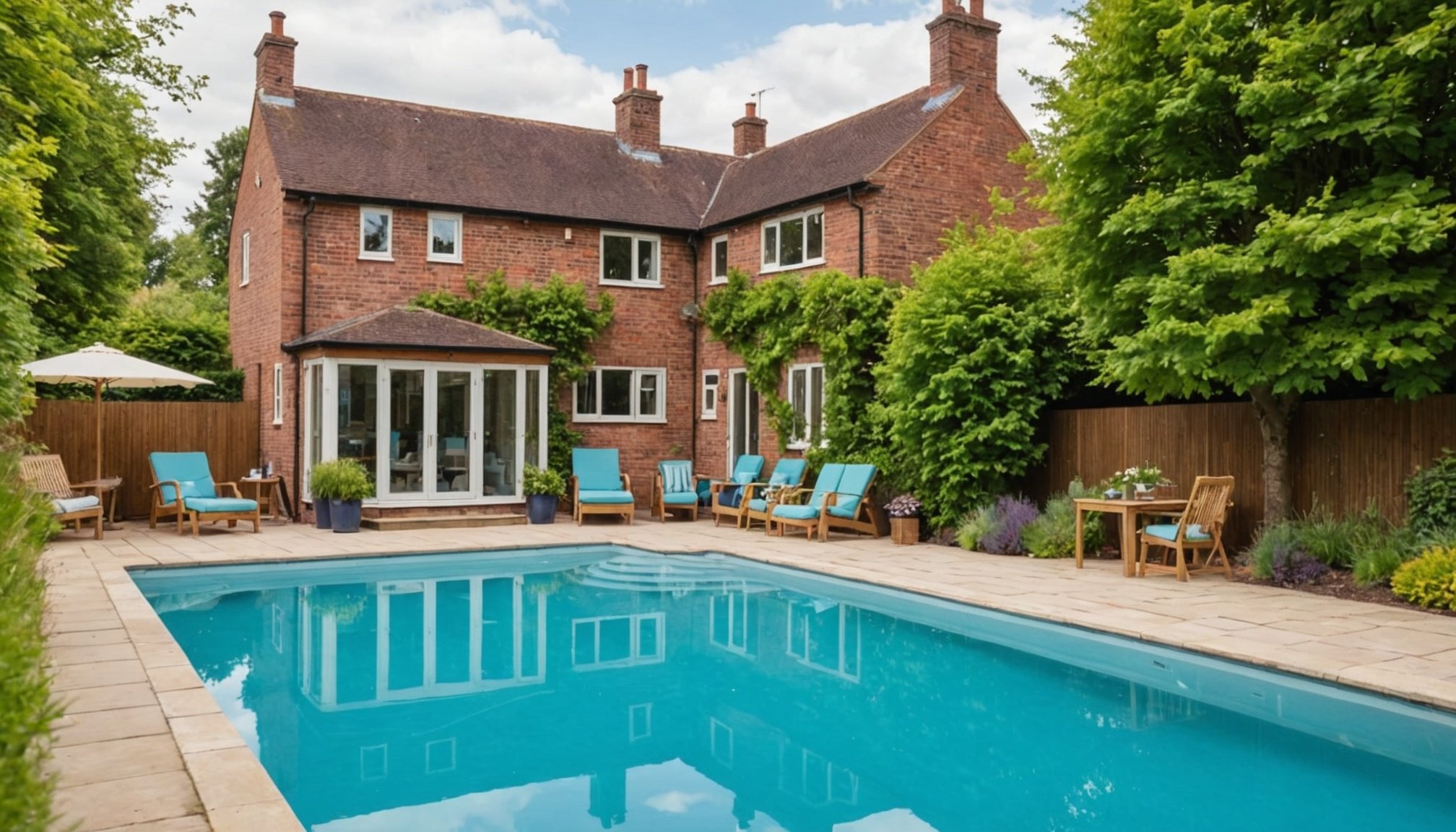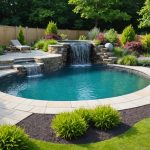Understanding the Importance of a Safe Pool Area
Creating a safe pool environment is essential for families with children. Young ones are naturally intrigued by water, which introduces specific safety concerns. By understanding these concerns, you ensure that your pool area is both family-friendly and secure.
One primary aspect of pool safety is adhering to UK regulations designed to protect everyone, especially children. These regulations require appropriate fencing, gates, and warning signs around pool areas, ensuring restricted access when unsupervised. Compliance not only promotes safety but also shields families from potential legal issues.
Additional reading : Creating the Ultimate Dual-Purpose Pool for Relaxation and Fitness in Your UK Home
A well-designed pool area balances safety and enjoyment. Invest in non-slip surfaces to prevent accidents and consider incorporating a visible marker for depth changes. Regular maintenance is crucial to keep the environment safe and clean. Ensuring pool equipment, such as ladders and diving boards, are securely attached and in good condition further emphasizes safety.
Furthermore, incorporating child-oriented features such as shallow areas or gradual slope entries can enhance the family-friendly appeal of your pool. Supervision is paramount, so designing the space to allow for easy monitoring enriches the overall safety. By focusing on these important aspects, families can feel assured, knowing their pool space offers both fun and protection.
In the same genre : Transform Your UK Garden: Creative Ideas for Designing a Stunning Pool with a Waterfall Feature
Essential Design Tips for a Kid-Friendly Pool Area
Creating a child-friendly outdoor space is essential for safe and family enjoyment. Designing a pool area that caters to both kids and adults can be a delightful challenge, but with the right pool design ideas, you can create a welcoming environment.
Selecting the Right Pool Style
When choosing a pool style for family enjoyment, consider different types of pool designs that cater to all age groups. Rectangular pools with graduated depths are ideal, offering shallow areas for beginners and deeper ends for experienced swimmers. Incorporate playful features such as shallow ledges or beach entries, which are not only fun but enhance water safety for children.
Integrate landscaping that complements the pool area. Natural barriers like hedges or decorative fences can define the space beautifully while preventing unwelcome access when unsupervised. Thoughtfully selected trees and shrubs can provide shade, reducing the risk of sunburn while enhancing the area aesthetically.
Creating Safe Zones Around the Pool
Safety is paramount. Ensure poolside surfaces are slip-resistant to minimise accidents. Materials like textured concrete or non-slip tiles provide stability even when wet. Design shaded zones using umbrellas or pergolas, protecting sensitive skin from harsh sunlight. Be strategic with furniture placement; ensure visible vantage points for parents to supervise children effortlessly.
Safety Measures for Pool Usage
Ensuring pool safety is crucial, especially for families with children. One of the most essential measures you can take is to maintain constant adult supervision around the pool area. Children are naturally curious and can easily find their way into the pool without realizing the potential dangers. Always having an adult present near the water can significantly reduce the risk of accidents.
In addition to supervision, emergency preparedness should be a top priority. This includes having a first aid kit and life-saving equipment, like pool noodles or life rings, readily accessible. It’s also wise to familiarize yourself with basic CPR techniques, as they can be invaluable in an emergency. Preparedness goes beyond equipment; it encompasses knowing how to react promptly and effectively in high-pressure situations.
Establishing clear rules and guidelines is another vital element of pool safety measures. Communication is key; ensure all pool users understand the safety protocols. Such rules might include no running, no diving in shallow water, and never swimming alone. By instilling these guidelines, you cultivate an environment of safety and responsibility around your pool.
Product Recommendations for Enhancing Safety and Fun
Ensuring both safety and enjoyment in pool areas is essential, especially with children around. Selecting the right swimming safety products can significantly reduce risks and enhance experiences for all pool users.
Safety Products for Pools
When considering safety, installing pool alarms and fences is crucial. These swimming safety products provide alerts and barriers, deterring unsupervised access to the pool area. Additionally, safety covers protect the pool surface, preventing accidental falls.
Personal flotation devices and life jackets are indispensable for non-swimmers and young children. They offer buoyancy and peace of mind. Ensure these accessories are correctly fitted and in good condition for optimum protection.
A comprehensive first aid kit is another must-have. Accidents can happen, and having a first aid kit readily available ensures timely response to any minor injuries or emergencies. Stock your kit with essentials like bandages, antiseptics, and CPR masks.
Fun Accessories for Kids
To enhance the fun, consider playful pool accessories. Floating games like toss rings and water volleyball engage children and adults alike. Add variety with water-friendly furniture—floating loungers or inflatable chairs turn relaxation into an interactive experience.
Adding themed decor to your pool area can also create an inviting and exciting environment. Accessories like colourful lights or character-themed inflatables contribute to an enjoyable, family-friendly setting.
DIY Options for Crafting a Pool Area
Creating a safe and inviting family pool area on a budget can be fulfilling and fun. Embracing DIY pool projects not only gives you a chance to add personal touches but also allows for creativity in crafting a unique environment.
Simple enhancements can make a world of difference. Consider installing non-slip surfaces to prevent accidents and soft edges around the pool for enhanced safety. Building a small fence with a self-closing gate is another budget-friendly option that enhances security without compromising aesthetics. These minor improvements are crucial for a kid-friendly pool area where safety remains a priority.
Budget-friendly designs can include multi-functional furniture like reclaimed pallet loungers, which add character and comfort without a hefty price tag. Creating shaded areas with reused umbrellas or homemade sails not only protects from the sun but also adds a touch of style.
For easy maintenance, regular cleaning is key. Use natural solutions, such as a vinegar and baking soda mix, for eco-friendly cleaning that’s both effective and safe for kids. Remember to check pool chemical levels frequently, ensuring a safe and healthy swimming environment.
By focusing on practicality and creativity, DIY pool projects can transform your space into an enjoyable, safe, and cost-effective oasis for the whole family without sacrificing fun.
Local Regulations and Compliance
Navigating the UK pool regulations landscape is crucial for any homeowner considering the addition of a residential pool. The UK has established several legal requirements intended to maintain safety and proper environmental standards. Among these, acquiring the necessary permits from local councils is paramount. This is not just a homeowner responsibility; it’s a mandatory step to ensure the pool meets the national health and safety criteria, including adherence to building codes and environmental guidelines.
Homeowners must also ensure their pools undergo regular inspections, which verify that safety features such as fencing and covers are installed and maintained correctly. The importance of this ongoing diligence cannot be understated, as it directly impacts both the safety of the residents and visitors and compliance with the UK pool regulations.
Legal requirements further dictate that emergency features, like pool alarms and non-slip surfaces, are not only advisable but sometimes required. It’s the homeowner’s role to remain informed and proactive about these regulations, as failing to comply can lead to severe penalties. Compliance ensures safety for all parties involved and reflects a commitment to maintaining a secure residential environment. Understanding and performing these responsibilities effectively shields against potential legal repercussions.











